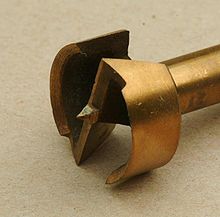Forstner bit
Forstner bits (also known as knothole bits ) are bits for holes with a diameter of 8 to 150 millimeters. They are named after their inventor, the American Benjamin Forstner (1834-1897), who applied for a patent for this type of drill in 1886.
Forstner bits have a short tip for positioning and centering, two cutting edges and peripheral cutting edges for pre-cutting the edge of the hole. The drill head tapers upwards to reduce friction. Forstner bits are in the woodworking industry for the production of blind holes used can be in particular knots very precise boring. Due to the good guidance, the shape of the circumferential cutting edges enables laterally open holes. Another application is the production of mounting holes for concealed hinges in furniture.
A modification of the Forstner bit is the artificial bit , whose peripheral cutting edges are replaced by smaller, specially shaped spurs.
The Forstner bit, like other drills, is not an independent tool, but is counted as an accessory to a drilling machine .
Individual evidence
- ↑ Steven Willson: Popular Mechanics Encyclopedia of Tools and Techniques . Hearst Books, 1994, ISBN 0-688-12460-7 , p. 201
- ↑ Patent CA23548 : Auger. Published March 6, 1886 , inventor: Benjamin Forstner.
- ↑ a b Wolfgang Nutsch and others: Fachkunde für Schreiner (12th edition), Verlag Europa-Lehrmittel, Wuppertal 1980, page 250, ISBN 3-8085-4011-7

